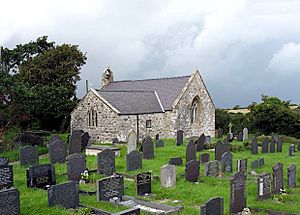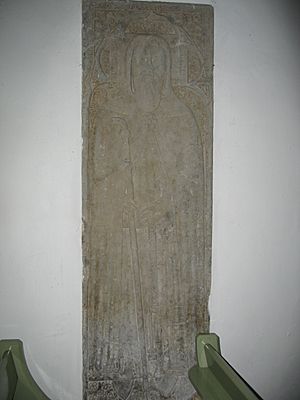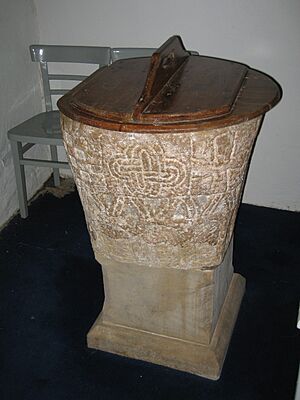St Iestyn's Church, Llaniestyn facts for kids
Quick facts for kids St Iestyn's Church, Llaniestyn |
|
|---|---|

St Iestyn's Church, with the south transept (left) and east window (right)
|
|
| Lua error in Module:Location_map at line 420: attempt to index field 'wikibase' (a nil value). | |
| OS grid reference | SH 585 796 |
| Location | Llaniestyn, Anglesey |
| Country | Wales |
| Denomination | Church in Wales |
| History | |
| Status | Church |
| Founded | Unknown, but possibly 7th century; earliest part of building is from the 12th century |
| Founder(s) | St Iestyn |
| Dedication | St Iestyn |
| Architecture | |
| Functional status | Active |
| Heritage designation | Grade II* |
| Designated | 30 January 1968 |
| Style | Medieval |
| Specifications | |
| Length | 38 ft 3 in (11.7 m) |
| Width | 15 ft 6 in (4.7 m) |
| Other dimensions | South transept: 18 by 15 feet (5.5 by 4.6 m) |
| Materials | Rubble masonry |
| Administration | |
| Parish | Beaumaris with Llanddona and Llaniestyn |
| Deanery | Tindaethwy |
| Archdeaconry | Bangor |
| Diocese | Diocese of Bangor |
| Province | Province of Wales |
St Iestyn's Church, Llaniestyn is a very old church located in Llaniestyn, Anglesey, in Wales. People believe that St Iestyn started a church here in the 600s. The oldest parts of the building you see today were built in the 1100s.
The church was made bigger in the 1300s, and more changes happened over the years. Inside, you can find a special stone font from the 1100s. There's also a memorial stone from the 1300s dedicated to St Iestyn himself. This stone was made by the same artists who created the stone for St Pabo at St Pabo's Church, Llanbabo.
St Iestyn's Church is still used for worship today. It is part of the Church in Wales and is one of seven churches in a larger group called a parish. The church is considered a very important historical building. It has a "Grade II*" listing, which means it's a "particularly important building of more than special interest." This is because it's so old and still has many of its original features, like the special stone carving of St Iestyn.
Contents
What is the History of St Iestyn's Church?
St Iestyn's Church is in a quiet, countryside area of eastern Anglesey. It's close to the village of Llanddona. The church actually gave its name to the area of Llaniestyn. The Welsh word llan first meant "enclosure" and then "church." The saint's name was added to it.
No one knows exactly when the church was first built. However, experts think that St Iestyn started a religious community here in the 600s. St Iestyn was a nephew of another famous Anglesey saint, St Cybi. This church was the last one that St Iestyn founded.
Records show that there was a church here before the year 1254. The oldest parts of the building we see now, like a door that is no longer used, are from the 1100s. The part of the church where the altar is, called the chancel, was likely made longer in the 1300s. The large window at the east end is from the 1400s, and the south door was added around 1500. In the 1500s, a side section called the south transept was built.
The church has been repaired and updated over the years. In 1865, the roof was replaced, and a new window was added on the north side. More work was done in 1954, which is when the old west door was found.
St Iestyn's Church is still an active place of worship today. It is part of the Church in Wales. It is one of seven churches in the group called the benefice of Beaumaris with Llanddona and Llaniestyn. The church is part of the Diocese of Bangor. As of 2025, the main priest, called the rector, is the Reverend Neil Fairlamb.
What Does St Iestyn's Church Look Like?
The church was built using rough rubble masonry, which means stones that haven't been shaped much. Some parts of the church are covered in render, a type of plaster. The main part of the church, including the chancel (where the altar is) and the nave (where people sit), is about 11.66 meters long and 4.72 meters wide. The south transept, a side section, is about 5.5 meters by 4.5 meters. The walls inside are painted white. The roof is made of slate.
There isn't a clear change in the building's structure to show where the nave ends and the chancel begins. There's a small tower for a bell, called a bellcote, at the west end of the roof. You enter the church through a porch on the south side. This porch has been rebuilt, but some of its materials are from the 1400s. Inside the porch, there's a round-topped door within a square frame. The date 1764 is on the door's hinge.
The east window in the chancel has a pointed arch shape and is from the 1400s. It has three sections of glass with decorative tops. On the north side of the nave, there's a rectangular window that was added in 1865. The south transept, built in the 1500s, has windows on its south and east walls. The south window has three sections with clover-shaped tops. The east window is small and rectangular, using some stone decorations from the 1300s. A large wooden beam crosses the wide opening between the transept and the rest of the church.
What Special Features are Inside the Church?
On the west wall of the south transept, there's a carved stone statue of St Iestyn. It was made in the late 1300s. St Iestyn is shown wearing a hooded cloak with a brooch. He holds a staff in his right hand and a scroll with writing in his left. He has a beard and looks like a hermit, someone who lives alone for religious reasons. Some people think he looks like a Franciscan friar, a type of monk. There are flowers carved in the background.
Historian Peter Lord believes the details of the staff and brooch are so accurate that the sculptor must have copied real items that people already respected. The writing on the stone says, "Here lies Iestyn to whom Gwenllian ferch Madog and Gruffydd ap Gwilym offered this image for the health of their souls." This means Gwenllian and Gruffydd paid for the statue to help their souls.
The stone is made of grey sandstone from Flintshire, in north-east Wales. Gruffydd ap Gwilym, who helped pay for the statue, owned land in Flintshire and also at Llaniestyn. He probably paid for other rebuilding work at the church too. Gwenllian was Gruffydd's aunt. This stone was made by the same artists who created similar memorials in the area. There's one at Bangor Cathedral and another for St Pabo at St Pabo's Church, Llanbabo on Anglesey. The stone might have originally been part of a special place for the saint. In the 1700s, it was in front of the altar, but it was later moved to where it is now.
The round font, used for baptisms, is at the west end of the nave and dates from the 1100s. The outside of the font has carvings in three rows. The bottom row has round-topped arches. The middle row has zigzag patterns. The top row has different crosses, checkerboard patterns, and other decorations. Its design is similar to the font at St Peulan's Church, Llanbeulan.
On the north wall of the chancel, there's a stone tablet from the 1700s. It lists gifts given to help the poor people of the area. The communion table and the rails around it are from the late 1600s.
Why is St Iestyn's Church Important?
St Iestyn's Church is recognized nationally and protected by law. It is a Grade II* listed building. This is the second-highest level of protection, meaning it's a "particularly important building of more than special interest." It received this status on January 30, 1968. It was listed because it is a "good Medieval rural church which retains many original and early features." Cadw, the Welsh Government group that protects Wales's historical buildings, especially highlights the "fine 14th-century effigy memorial" of St Iestyn.
In 1847, a clergyman named Harry Longueville Jones said that the church was one of the "plainest" in Anglesey, but it had "two treasures." He called the font "remarkably curious." He also said that there were "few monumental effigies in Wales of a higher antiquarian value" than the image of St Iestyn. A guide to the buildings of the region from 2009 describes the church's entrance porch as "barn-like." It also calls the statue of St Iestyn "surprisingly accomplished," meaning it's very well made.




